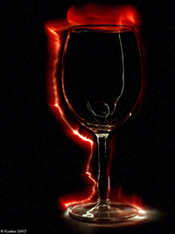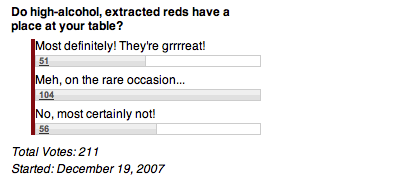Is the clock ticking on hedonistic fruit bombs?
 Is the backlash against “hedonistic fruit bombs” gaining speed? Previously in the year we’ve noted that they don’t age, a retailer who refuses to sell wine over 14.5% alcohol, and a Napa winemaker who said “higher alcohol wines should stop.â€
Is the backlash against “hedonistic fruit bombs” gaining speed? Previously in the year we’ve noted that they don’t age, a retailer who refuses to sell wine over 14.5% alcohol, and a Napa winemaker who said “higher alcohol wines should stop.â€
Now, the recent developments:
1. Neal Martin, a meta-critic at Robert Parker’s The Wine Advocate, trashes the 2003 Bordeaux vintage.
2. Garagiste wines, the Parker darlings (such as Jean-Luc Thunevin of Valandraud who has admitted that Parker “made” the property with his reviews), are seeing less interest at auction. In her review of the year in wine auctions, Elin McCoy writes on Bloomberg: “Not everything was selling. At Sotheby’s, buyers passed on once popular Bordeaux garagiste wines like Monbousquet…”
3. I spoke with a head buyer at a leading wine store in NYC recently and he told me that sales of Australian wines over $10 are down 60% at his store over the past three years. I expressed surprise. He said he’s talked to other buyers and they have noticed similar softening. Why? “I guess people are people are starting to realize that with that sort of wine, you don’t really gain a lot over $10,” he said.
Have your say in the latest poll!

poll now closed
(image)




On December 20th, 2007 at 10:42 am ,Jason Ohmann wrote:
This certainly is an interesting topic. Like many men I went through the “palate attacker” phase as I like to call it, only to come out the other side almost more a fan of the balanced subtle nature of an excellent white wine than a red (I said “almost”). I do sort of want to see less of these wines but, more importantly, I want to see less of an incentive for burgeoning winemakers to make their wines in this style to achieve commercial success. However, there’s a risk that the “trend pendulum” will simply swing the other way and wines that were maybe highly extracted and alcoholic in a good way (if there is such a thing) will cease to exist. I guess the long and short of it is that trends shouldn’t dictate how a winemaker makes wine. I know I know, I’m living a delusion.
Take Californian Chardonnay for example. Now that everyone has “seen the light” regarding heavy oak and 100% malolactic fermentation, we seem to be missing those classy, lightly oaked Chardonnays that put California on the map in the first place. And while I’ll almost always choose less oaky over more, there are some oaky Chardonnays that I love and I miss dearly. The same is true for the “bombs”. While I’ll always prefer lower alcohol, balanced wines, there are some truly fun wines out there that deserve to keep their style, even if I’m not drinking them every day.
On December 20th, 2007 at 2:29 pm ,Steve Heimoff wrote:
Tyler, I don’t know if the “clock is ticking” metaphor, with its underbodings of doom, is quite appropriate. But I do believe, in fact I know, that there’s been a backlash building for some time against fruit bombs. One senses it everywhere in California, not necessarily among those winemakers who make wines of that style, but among practically everyone else. The big, ripe, rich Cabs, Syrahs, etc. won’t disappear overnight, nor should they. But what I wonder is, What does this anti-fruit bomb trend mean for California, which produces them so effortlessly? Is California, with its hot summers and harvests, capable of producing a drier, lighter style of wine, especially with the Continental varieties it specializes in (Cab, Merlot, Syrah, Pinot Noir, Chard and so on)? But I agree with Jason: Some of the oaky “fruit bombs” are absolutely delicious and in their own way, world-class.
On December 20th, 2007 at 5:16 pm ,Joe wrote:
Great topic. For me, it’s not the fruit that bothers me, but the ‘bomb’ of super-blowsy alcohol. I recently had a Zin at 15.9%, and it’s just… too much. I mean, isn’t that getting into Port territory?
On December 20th, 2007 at 6:08 pm ,Steve Heimoff wrote:
Joe: Yes.
On December 21st, 2007 at 8:58 pm ,Matt wrote:
It’s a shame that Australia has come to be associated only with big, heavy, high alcohol wines.
While the most popular wines certainly fit that profile, there a million gems from regions such as Margaret River that certainly don’t fit that profile. Try a Moss Wood, Cullen or Howard Park bottle for an example of what Aussies can do.
On December 22nd, 2007 at 11:16 am ,Dr. Vino wrote:
These are great comments! I would agree that it is the “bomb” part of the high alcohol that irks me the most. I tried two syrahs recent, a Cote-Rotie at 12.5% and a Sonoma syrah at 15.5%. Although they were both well made in their particular style, I preferred the lower alc one, in part because it had less new oak as well as the lack of sweetness that also comes with higher alcohol (and new oak).
Fruit bombs can be fun in a one glass sort of a way. Kind of like driving an Escalade–fun as a rental, perhaps, but who wants to pay the fuel bill on that thing?
Steve – yes, California winemakers can make these big wines effortlessly, but can they not also make more restrained wines with perhaps a bit more effort? Corison and Clos du Val are very near practitioners of the not-so-big style after all.
Matt – good point about Aussie reds being painted with a broad brush here in the US. Sad but true. I recently tasted through a bunch of Coonawarra Cabs and found them wildly different than Barossa shiraz. It’s just that you don’t see that many Coonawarra cabs here, in part, because the Aussies drink them at home and don’t export as many…
On December 23rd, 2007 at 11:42 am ,Bernie Bearnaise wrote:
Wines are as individual as the palates that taste them. While I’ve historically gravitated towards the balanced blends of Bordeaux, there is something to be said for diversity and experimentation. I tasted four 2006 wines yesterday from the same Rosedale, Barossa vinyard and they all tasted different but all displayed a clean jammy fruit that most definitely extracted. They were all over 15% but the alchohol did not seem obtrusive or hot. The varietals were Shiraz/Grenache, Shiraz/Cabernet Sauvignon, Shiraz and Cabernet. I thoroughly enjoyed these wines and would definitely recommend them to a friend. They also were high quality versus the price. They all had the Stelvin Cap too which I disdain. The producer is Cat Amongst the Pigeons. I ranked them in this order: Fat Cat, Alley Cat, Nine Lives and Cat Walk. So much for preconceptions…
Please try them yourself share your thoughts.
On December 23rd, 2007 at 4:49 pm ,rohan wrote:
There’s still aplace for fruit driven hedonistic wines as this is the expression most wine makers are aiming for. The greatest burgandies, clarets, brunellos, calicabs, oz shiraz are all about fruit. Yes there needs to be a backbone and there needs to be complexity but the better the fruit the more there is of this as well. It is possible to make lean, vegetal, stalk driven wines but thankfully there does not seem to be a mass market for them any more.
On the australian debate we have prostituted ourselves to the british supermarkets and the insanely sweet tooth of the average buyer. The english wine writers like to portray the populace as the most sophisticated on earth but the reality is that alcoholic ribena with a pretty label would sell volumes (and does). That said there is a great selection of wines in the UK but hardly anything from the US & Argentina. Come on let us taste your good stuff.
On January 2nd, 2008 at 1:43 am ,Vino da Burde - » D’Arenberg The Laughing Magpie Shiraz-Viogner McLaren Vale 2004 wrote:
[…] è che sia cattivo ovviamente ma avete presente quelle “hedonistic fruit bombs” di cui parlava giorni fa Dr Vino? Ecco, uno di quelli… Colore scurissimo da marmellata di mora, consistenza sciropposa, […]
On January 24th, 2008 at 3:37 pm ,Tom Farella wrote:
I love this subject but have little hope that it will actually happen anytime soon. I have read and heard about this subject for a few years now but the whole system is driven by Parker and Spectator points to an extreme fault. It’s a vicious cycle that will not go away until even ONE highly-followed wine writer will take a stand with POINTS. Yes, a balanced wine getting 95 big ones. It won’t happen as long as the wine writers are watching their backs, trying to out-gun each other and stop blabbing about this and actually put their palate where their mouth is. Meanwhile, the system needs to introduce quality-per-a-given-style points and we might actually evolve out this abyss.
On May 27th, 2010 at 9:24 am ,STEVE HEIMOFF| WINE BLOG » Blog Archive » We want stronger food tastes. What about our wines? wrote:
[…] couple years ago, Dr. Vino wrote an influential blog post called “Is the clock ticking on hedonistic fruit bombs?†He didn’t come right out and say so, one way or the other. But he cited evidence of a […]
On November 29th, 2010 at 10:26 am ,STEVE HEIMOFF| WINE BLOG » Blog Archive » Truth, lies and alcohol in California wine wrote:
[…] that the article could have been written years ago, and, in fact, was, by Dr. Vino, in his blog, “Is the clock ticking on hedonistic fruit bombs?†People have been complaining about high alcohol in California wine for a decade if not longer, so […]